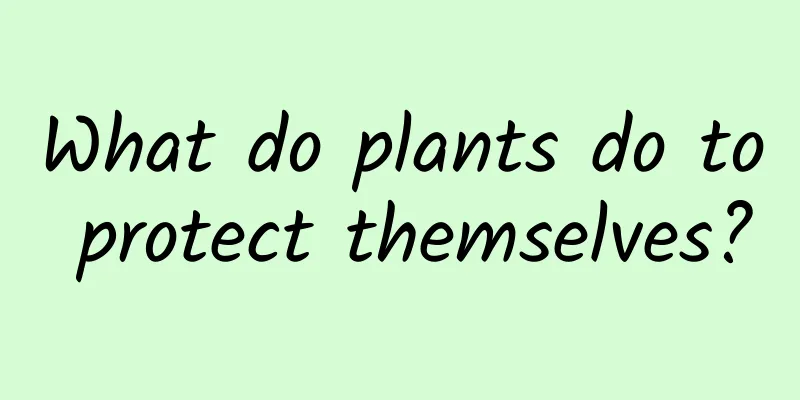What do plants do to protect themselves?

|
In nature, plants are always at a disadvantage, as if they have been "used" or even eaten by other animals throughout their lives. Even fungi, bacteria, aphids, caterpillars, etc. can bully them at will. Herbivores search for and eat leaves, roots, flowers and seeds of plants day and night to obtain abundant water and nutrients. Some carnivores will occasionally change their taste and eat some grass to aid digestion. But plants are not always so submissive. Plants: You all eat me and bully me, but I also have a temper. Today I will show you our unique self-protection skills. Plants have a series of self-protection mechanisms from the inside out. As a result of long-term evolution, they are unpalatable, inedible, or even poisonous. Most trees have hard bark, which is full of lignin and is very difficult to swallow. This ensures that no animals will choose to eat the bark under normal circumstances. At the same time, it is also a hard protective layer that can isolate external pathogens. Don't be fooled by the way leaves look weak. In fact, each leaf is fully armed. Most plants have a waxy cuticle on their leaves, which can prevent insects and microorganisms from eating them to a certain extent. Some plants go a step further and create structures that can cause harm to the threat - thorns. They usually grow prominently on the stems of plants, some are large and sharp, and some are small and dense. They are all to warn the outside world that "I can't eat it". For some small pests, the large thorns can hardly hurt them. So the epidermal hairs on the leaves have a say, which is a very sharp hair-like structure. Insects like worms will feel uncomfortable crawling on leaves with epidermal hairs. The epidermal hairs of some plants also release chemicals, such as stinging nettles, which release a mixture of histamine and toxins when touched, which can cause stinging sensations or even inflammation and allergies in people or animals who touch them. Other smart plants will cause oral pain when chewed by herbivores, such as pineapples and kiwis, which are common in our lives. They contain a lot of proteases, which will break down proteins on the tongue and oral mucosa, causing discomfort. As powerful humans, we naturally have ways to solve this problem, but the small animals are helpless. After experiencing this sour taste, they will habitually stay away from these plants. There is another plant that everyone must know, the Mimosa pudica. They go to great lengths to prevent being eaten. When an organism touches their leaves, the sensor cells in the leaves send electrical signals to the roots, causing the cells to release charged particles, which causes water to leave the cells. At the same time, the leaves shrink and close. This sudden movement will scare away any threat, and the fish will look limp and dead, so other animals won't want to eat it. If the above external defenses fail, the plant will activate its own immune system. Plants do not have their own independent immune system like animals, but every cell in a plant can detect and defend against invaders. They have special receptors that can recognize and display cells that have been invaded by microorganisms or insects. When plants detect these dangers, their immune system kicks in. To prevent more pathogens from entering, the waxy cuticle on the leaves thickens, the cell walls become stronger, and the pores on the leaves close to protect the cells. When plants are infected by microorganisms, healthy cells near the infected cells will sacrifice themselves in a righteous manner, using this suicidal behavior to build an isolation layer to prevent other cells from being infected. After a long period of evolution, plants have also produced a variety of synthetic toxins to fight microorganisms and bacteria. These toxins are often tailor-made for a certain organism or pathogen. So later we used it to make various antibacterial drugs, condiments and poisons. Plants like tomatoes have also evolved a "warning system." When one tomato plant is damaged, it releases electrical signals to alert other tomatoes on the same plant. This tomato plant will also release hormones and chemical volatiles to other tomatoes of different plants. After receiving the signal, other tomatoes will speed up the production of defense substances. Slowly, the whole piece of tomatoes will enter a state of alert. Some plants, if they are unable to deal with pests themselves, will call for help. For example, cotton is very smart. When caterpillars appear on the plant, cotton will release 10-12 mixed chemicals into the air. These odors will attract parasitic wasps, which will lay eggs in the caterpillars and slowly kill them, helping the cotton plant eliminate pests while also reproducing itself. Plants don't have teeth or claws, and they can't run away after being attacked. But they have tough skin, rich chemical weapons, and can cooperate with each other and even form cross-species alliances. So, do you still think plants are weak? |
>>: Can fish without eyelids also "blink"?
Recommend
Musk promoted Tesla, but 3025 electric vehicles were removed from the shelves in China on the same day
At noon on July 6, Beijing time, Musk showed the ...
24-hour emergency response | A bus overturned in Hong Kong, causing 1 death and 11 injuries
Hot News TOP NEWS One new local confirmed case in...
Young people please eat less sweets! A study of 30,000 people found that drinking one cup of sugary drink a day increases the risk of colon polyps by 34%!
The incidence of colorectal cancer among young pe...
Ximalaya FM Product Experience Analysis Report (Part 2)
As the largest audio platform in China, Himalaya ...
Lily SEO Training: What are the aspects of search engine friendliness?
First: Directory Structure A clear and concise di...
Using macaca for mobile hybrid automation testing (Part 4)
Now it is time to test the webview in native. For...
How to master fan circle marketing?
The "2018 White Paper on Chinese Youth Socia...
Tik Tok "Enterprise Certification" is online, all issues are explained!
The Douyin "Enterprise Certification" t...
Tesla to use rare earth permanent magnets to drive electricity in preparation for entering China
Tesla purchased neodymium iron boron magnets for ...
Can multi-screen interaction on smart TVs really improve user experience?
Multi-screen interaction centered on TV has gradu...
How to improve conversion rate? Here are 9 suggestions for you!
A design change can increase website click-throug...
How to design new product invitation activities to promote products themselves (Part 1)
This article is a summary of the results of a use...
Cao Cao VS Liu Bei, where should the male god Guan Yu go?
Mixed Knowledge Specially designed to cure confus...
A 10,000-word summary of how to attract fans to public accounts, 5 tricks to break the dilemma of attracting new users!
If you happen to be running a public account and ...
Shared bicycles are so popular that power banks are also joining in the fun. Why are Tencent and Xiaomi investing hundreds of millions but being ridiculed by Wang Sicong?
With the emergence of shared bicycles, the "...









